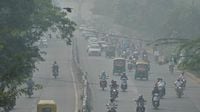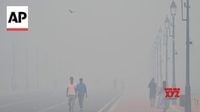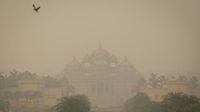On October 21, 2025, the city of New Delhi awoke to a sight that has become all too familiar in recent years: thick, choking smog blanketing the streets, monuments, and high-rises of India’s bustling capital. The morning after Diwali, the revered festival of lights celebrated by millions across India and beyond, brought with it an air quality crisis that once again pushed the city into the global spotlight for all the wrong reasons.
According to the Associated Press, revelers in New Delhi had burst firecrackers late into the night, filling the air with smoke and fine particles. These pollutants mixed with the city’s already-present seasonal pollution and stagnant weather conditions, creating a hazardous cocktail that lingered well into the morning. By sunrise, the city’s Air Quality Index (AQI) had soared above 350 in several neighborhoods—a level considered “severe” and dangerous to breathe by the World Health Organization’s daily recommended maximum exposure.
Visibility plummeted as a gray haze settled over the city, obscuring even its most iconic landmarks. “I have never seen anything like this before. We can’t see anything here because of pollution,” said Vedant Pachkande, a tourist visiting New Delhi, as quoted by Sky News. For residents and visitors alike, the smog was an unwelcome reminder of the city’s ongoing environmental struggles.
It wasn’t just local monitoring agencies raising the alarm. Swiss air quality group IQAir recorded a reading of 442 for New Delhi that day, officially making it the world’s most polluted major city at that moment. With such staggering numbers, the health risks were immediate and severe. Respiratory illnesses, eye irritation, and general malaise were reported by many among the city’s more than 30 million residents, as the toxic air made simple tasks like walking to work or school a challenge.
This year’s post-Diwali pollution spike came on the heels of a controversial decision by India’s Supreme Court. In the week leading up to the festival, the court relaxed a blanket ban on firecrackers, allowing the limited use of so-called “green crackers”—a newer type of firework developed by federal research institutes and designed to cut particulate and gas emissions by about 30% to 50%. The court specified that these could be used during specific hours from Saturday to Tuesday, with a maximum of three hours each on Sunday and Monday.
Yet, as Reuters and the Associated Press both reported, the rules were widely flouted. Firecrackers were set off well outside the permitted hours, and the intended environmental benefits of the green crackers were largely lost in the haze of widespread non-compliance. The result? Air pollution levels that rivaled or even surpassed those of previous years, despite the new regulations.
New Delhi’s pollution woes are not limited to Diwali alone. The city and its metropolitan region, home to more than 30 million people, routinely rank among the world’s most polluted during the winter months. The reasons are manifold: cooler weather traps pollutants close to the ground, while smoke from crop residue fires set by farmers in neighboring states adds to the toxic mix. Construction dust, vehicle emissions, and industrial output all contribute to the city’s persistent air quality problems.
Authorities in New Delhi have not been idle in the face of this crisis. Measures implemented to curb pollution include limits on construction activity and restrictions on the use of diesel generators—two significant sources of particulate matter in the city’s air. However, as environmentalists have repeatedly pointed out, these short-term fixes are not enough to address the underlying causes of the city’s annual air quality emergency.
“Long-term solutions, such as cleaner energy and stricter vehicle-emission controls, are needed to prevent the annual crisis,” environmental advocates emphasized, as cited by the Associated Press and Sky News. The sentiment is echoed by many residents and experts alike who see the current measures as mere band-aids on a much deeper wound.
The health impacts of such hazardous air are profound and far-reaching. According to the World Health Organization, exposure to air pollution at the levels recorded in New Delhi can lead to a host of respiratory and cardiovascular issues, particularly among children, the elderly, and those with pre-existing health conditions. Hospitals in the city often report a surge in admissions for asthma, bronchitis, and other pollution-related ailments in the days following Diwali.
But the consequences of New Delhi’s smog extend beyond immediate health concerns. A study published in October 2025 in Scientific Reports—a journal by Nature Portfolio—found that sunshine hours have steadily declined across most of India due to rising air pollution. The researchers, led by Manoj K. Srivastava of Banaras Hindu University, attributed this drop to increasing aerosols—tiny particles from industrial emissions, biomass burning, and vehicle pollution. “We see a greater impact in more polluted regions such as northern India,” Srivastava noted. The reduction in sunlight not only affects the amount of solar power India can generate but also has implications for agricultural productivity and, ultimately, the local environment and people’s health.
The Earth Sciences Ministry has forecasted little relief for Delhi in the coming days, with air quality expected to remain in the “Very Poor to Poor” category. This grim outlook is a stark reminder that the city’s pollution problem is not a fleeting post-festival phenomenon but a persistent, systemic issue that requires urgent and sustained action.
India is not alone in facing such challenges. As Sky News pointed out, neighboring Pakistan has implemented an “emergency plan” to tackle pollution, including action against farm fires, smoke-emitting vehicles, and the use of anti-smog guns in polluted areas. The struggle for clean air is a regional one, affecting millions across South Asia each winter.
For now, the people of New Delhi are left to navigate the haze as best they can—donning face masks, staying indoors, and hoping for a change in the wind. The city’s annual post-Diwali smog has become a symbol of both celebration and crisis, a vivid illustration of the complex interplay between tradition, modernity, and environmental stewardship.
As the debate over firecrackers, crop burning, and urban emissions continues, one thing remains clear: without bold, coordinated action, the festival of lights will continue to cast a long, dark shadow over New Delhi each year.


